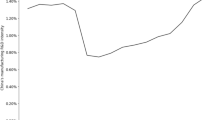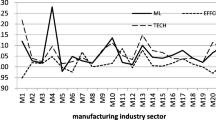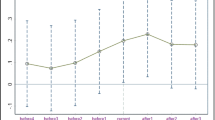Abstract
The equipment manufacturing industry is the industrial base of China, which makes it imperative to coordinate the relationship between industrial development and environmental protection. Using panel data of the seven sub-industries in China’s equipment manufacturing industry from 2011 to 2015, this paper evaluates the static and dynamic aspects of green economic development efficiency by combining the super-efficiency slack-based measure model of unexpected output and the data envelopment analysis-Malmquist index model. The results show investments in research and development, and environmental regulations have yielded some positive results, but that regulations have also yielded some undesired output in terms of diminished economic benefits. Pure technical efficiency and scale efficiency have both declined, indicating that the scale and industrial structure need to be further optimized. The results of this study present an objective and comprehensive assessment of green economic development of China’s equipment manufacturing industry and provide valuable insights for improving green economic development efficiency.


Similar content being viewed by others
References
Arimura TH, Sugino M (2007) Does stringent environmental regulation stimulate environment-related technological innovation? Sophia Econ Rev 52:1–14
Berman E, Bui LTM (2001) Environmental regulation and productivity:evidence from oil refineries. Rev Econ Stat 83:498–510
Bos JWB, Economidou C, Sanders MWJL (2013) Innovation over the industry life-cycle: evidence from EU manufacturing. J Econ Behav Organ 86:78–91
Brännlund R, Färe R, Grosskopf S (1995) Environmental regulation and profitability: an application to Swedish pulp and paper mills. Environ Resour Econ 6:23–36
Caves DW, Christensen LR, Diewert WE (1982) The economic theory of index numbers and the measurement of input and output,and productivity. Econometrica 50:1938–1414
Fare R, Grosskopf S, Norris M, Zhang ZY (1994) Productivity growth, technical progress and efficiency changes in industrialized countries. Am Econ Rev 84:66–83
Fortin HWM (2005) Spatial analysis of landscape:concepts and statistics. Ecology 86(8):1975–1987
Freeman AM, Haveman RH, Kneese AV (1972) Economics of environmental policy. Nature 376(6539):444–447
Gray WB, Shadbegian RJ (2003) Plant vintage, technology,and productivity, and environmental regulation. J Environ Econ Manag 46:384–402
He BJ, Zhao DX, Zhu J, Darko A, Gou ZH (2018) Promoting and implementing urban sustainability in China: an integration of sustainable initiatives at different urban scales. Habitat Int 82:83–93
Jaffe AB, Palmer K (1997) Environmental regulation and innovation: a panel data study. Rev Econ Stat 79:610–619
Jerath M, Bhat M, Rivera-Monroy VH, Castañeda-Moya E, Simard M, Twilley RR (2016) The role of economic, policy, and ecological factors in estimating the value of carbon stocks in Everglades mangrove forests, South Florida, USA. Environ Sci Pol 66:160–169
Kang YQ, Xie BC, Wang J, Wang YN (2018) Environmental assessment and investment strategy for China’s manufacturing industry: a non-radial DEA based analysis. J Clean Prod 175:501–511
Kuosmanen T, Bijsterbosch N, Dellink R (2009) Environmental cost-benefit analysis of alternative timing strategies in greenhouse gas abatement: a data envelopment analysis approach. Ecol Econ 68:1633–1642
Lanoie P, Patry M, Lajeunesse R (2008) Environmental regulation and productivity: testing the Porter hypothesis. J Prod Anal 30:121–128
Magat WA (1978) Pollution control and technological advance: a dynamics model of the firm. J Environ Econ Manag 5:1–25
Malmquist S (1953) Index numbers and indifference surfaces. Trab Estad 4(2):209–242
Matthews RCO (1981) Accounting for slower economic growth: the United States in the 1970s. Econ J 91:1044–1046. https://doi.org/10.2307/2232516
National Bureau of Statistics of China, Ministry of Ecology and Environment (2018) China Statistical Yearbook on Environment. China Statistical Press, Beijing
Porter ME, Claas VDL (1995) Toward a new conception of the environment-competitiveness relationship. J Econ Perspect 9:97–118
Qin G, Zhang P, Hou X, Wu S, Wang Y (2020) Risk assessment for oil leakage under the common threat of multiple natural hazards. Environ Sci Pollut Res 1–14. https://doi.org/10.1007/s11356-020-08184-7
Ramnathan R, Black A, Nath P, Muyldermans L (2010) Impact of environmental regulations on innovation and performance in the UK industrial sector. Manag Decis 48:1493–1513
Shen N, Liao H, Deng R, Wang Q (2019) Different types of environmental regulations and the heterogeneous influence on the environmental total factor productivity: empirical analysis of China’s industry. J Clean Prod 211:171–184
Stephens JK, Denison EF (1981) Accounting for slower economic growth: the United States in the 1970s. South Econ J 47:1191
Telle K, Larsson J (2007) Do environmental regulations hamper prodictivity growth? How accounting for improvenments of plants environmental performance can change the conclusion. Ecol Econ 61:438–445
Testa F, Iraldo F, Frey M (2011) The effect of environmental regulation on firms’ competitive performance: the case of the building & construction sector in some EU regions. J Environ Manage 92:2136–2144
Wang H, Xu J, Wang D, Zhang T, Liu Y (2015) Cleaner production based on sustainable development in Chinese power plants. Environ Eng Sci 32:6
Wang Y, Yan W, Ma D, Zhang C (2018) Carbon emissions and optimal scale of China’s manufacturing agglomeration under heterogeneous environmental regulation. J Clean Prod 176:140–150
Wang H, Xu J, Sheng L (2020) Purification mechanism of sewage from constructed wetlands with zeolite substrates: a review. J Clean Prod 258:120760
Yang CH, Tseng YH, Chiang CP (2012) Environmental regulations, induced R&D, and productivity; evidence from Taiwan’s manufacturing industries. Resour Energy Econ 34:514–532. https://doi.org/10.1016/j.reseneeco.2012.05.001
Yuan B, Xiang Q (2018) Environmental regulation, industrial innovation and green development of Chinese manufacturing: based on an extended CDM model. J Clean Prod 176:895–908
Yuan B, Ren S, Chen X (2017) Can environmental regulation promote the coordinated development of economy and environment in China’s manufacturing industry? A panel data analysis of 28 sub-sectors. J Clean Prod 149:11–24
Zhou M (2017) Valuing environmental amenities through inverse optimization: theory and case study. J Environ Econ Manag 83:217–230
Funding
This study is supported by the following projects: the Shandong Provincial Natural Science Foundation (ZR2019QG011) and the Shandong Provincial Social Science Planning project (18CJJZ01).
Author information
Authors and Affiliations
Corresponding author
Additional information
Responsible editor: Nicholas Apergis
Publisher’s note
Springer Nature remains neutral with regard to jurisdictional claims in published maps and institutional affiliations.
Rights and permissions
About this article
Cite this article
Li, W., Ouyang, X. Investigating the development efficiency of the green economy in China’s equipment manufacturing industry. Environ Sci Pollut Res 27, 24070–24080 (2020). https://doi.org/10.1007/s11356-020-08811-3
Received:
Accepted:
Published:
Issue Date:
DOI: https://doi.org/10.1007/s11356-020-08811-3




